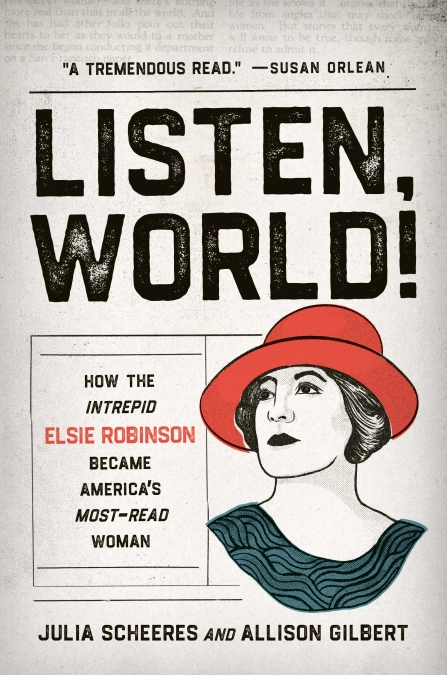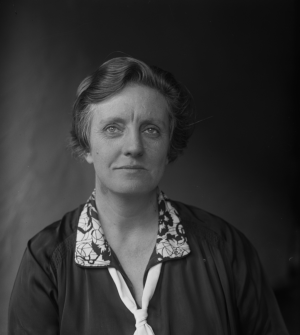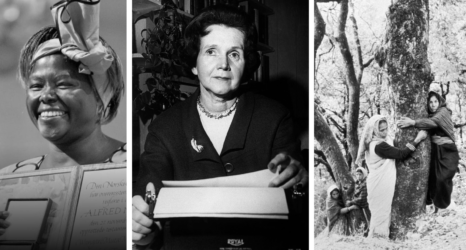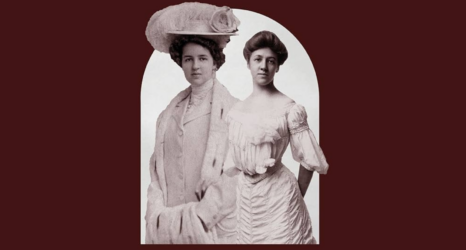
The following is an excerpt from Listen, World! How the Intrepid Elsie Robinson Became American’s Most-Read Woman by Julia Scheeres and Allison Gilbert.
Born into poverty in 1880s California, Robinson risked everything to chase her dream of becoming a writer and lead a life beyond what was prescribed to women at the time—even working in a gold mine as the sole female mucker as she tried to break into magazines. Ultimately, after a long and bumpy road, she succeeded and used her nationwide column to advocate for the rights of women, people of color and other underrepresented groups.
On March 4, 1940, Elsie Robinson wrote her boss the kind of scathing letter that she knew, in theory, could get her fired.
The famous columnist—whose opinions reached 20 million people a day and millions more through a vast syndication network—had just been offered a new contract at the same salary she’d been making for the past nine years.
Outraged, she told her editor that the deal was “plain stupid.” When her editor failed to advocate on her behalf, she decided to go over his head and appeal directly to the head of the company they both worked for—America’s most powerful publisher, William Randolph Hearst.
“The Chief,” as Hearst was called by those who worked for him, created the first media conglomerate in the world. By its 1930s height, he owned 28 newspapers in 19 cities; popular magazines including Good Housekeeping and Cosmopolitan; a radio network; and a film division.
Robinson was emboldened by her stature within the Hearst empire. He’d hired her in 1924 and paid her more than any other woman writer. For more than 15 years, her daily column, “Listen, World!,” was devoured by Americans across the country who valued her take on everything, from how to be happier, to the spread of communism. Robinson knew her worth.
Hearst sent one of his lieutenants, Abraham Merritt, a managing editor at one of his weeklies, to talk her down. Robinson wanted nothing to do with him.
“Confidential. Dear Chief,” she wrote. “Your Mr. Merritt talked to me the other day. He seems pretty smart. I let loose at last and told him a few of the private opinions that have been stewing in me for nearly 20 years. He asked me if I would write them on paper. Of course I’ll write them. Why should there be anything private in an organization like this?”
She listed her frustrations: Her workload was crushing (in addition to her daily column, she wrote features and breaking news); she hadn’t taken a vacation in a year; and yet, despite her dedication to her job, she was repeatedly denied a raise—not even given a modest bump.
After recounting her personal gripes, she launched into a criticism of the way Hearst was running his company, suggesting that he was losing his competitive and creative grip: “I knew you when you filled the whole horizon and licked twenty 20th Centuries. You didn’t let anything stay stagnant for six years or six weeks. I’m not insulting you when I talk like this. I’m just remembering the glory that was Rome.”
Robinson had spent her entire career seizing opportunities and defying convention. In 1918, she noticed that the Oakland Tribune didn’t have a children’s section and convinced the paper to hire her to create one. She both wrote and illustrated the stories. “Aunt Elsie’s Magazine” became a sensation, spawning “Aunt Elsie” clubs for kids across California. When she learned that parents were also fans of her work, she launched two popular advice columns geared at adults. In 1923, she scaled the much larger market of San Francisco with a third column, “Tell It to Elsie,” for the San Francisco Call and Post.
I know the comeback. ‘But we give you a really staggering sum for a woman writer.’ My answer is simple. I am not a columnist. I am a factory. You’ve not been getting a feature. You’ve been getting mass production for nearly 20 years.
Elsie Robinson

Robinson had always relied on her tremendous moxie to navigate life. In her early 30s, as a broke, single mom in the foothills of the Sierra Nevada, she’d talked her way into a gold mining camp where, for three years, she wore spiked boots and cheated death 600 feet below the earth’s surface—the only woman on a motley crew of prospectors. She spent evenings bent over a typewriter, trying to develop her skills as a writer.
Robinson remained just as fearless at 56 in her chastisement of “The Chief”—a man who lived on California’s central coast in a castle sprawling enough to accommodate 50 to 60 overnight guests. She’d dealt with male bosses for her entire career and refused to be intimidated by them.
“If I hadn’t improved on my stuff in nine years, I’d have been out on my ear in exactly eight years and 11 months,” she had told her editor. “I know the comeback. ‘But we give you a really staggering sum for a woman writer.’ My answer is simple. I am not a columnist. I am a factory. You’ve not been getting a feature. You’ve been getting mass production for nearly 20 years.”
What happened next suggests she was either placated or promised a future pay increase. Perhaps both. We know she wasn’t fired. Hearst continued to send her to cover the major stories for his papers, including the 1940 Democratic National Convention in Chicago, and he threw a luncheon in her honor at the lavish Warwick Hotel in New York.
Robinson kept writing at a finger-numbing clip for another 16 years, publishing as frequently as six days a week—producing approximately nine thousand columns and articles during her 40 year career. She was the most widely read female columnist of her day and reached double the number of current subscribers to the New York Times. She was also one of the first and only columnists in the country to draw her own blistering editorial cartoons to accompany her writing.
In addition to journalism, she wrote short stories and poems that were published in national literary journals and collected in “best loved” anthologies.
During a time of rapidly changing mores—the years following World War I, during the Great Depression, and after World War II—she went from offering advice to mostly female readers to expanding her audience by sounding off on larger political topics and social trends. She tackled gender inequality more than a decade before Gloria Steinem was born: “I’m tired of hearing the differences of men and women emphasized and exploited,” she wrote in April 1922. “It has built a wicked wall between the sexes and it’s time we knocked it down.” She denounced racism and anti- Semitism, condemned capital punishment, and advocated on behalf of immigrants.
But she rarely wrote about herself in her columns. Save for a few mentions of her 21-year-old son’s death, she divulged little about her personal life. For that reason, this biography—the first of Elsie Robinson—reveals both her remarkable body of work and the heartbreaking and surprising paths she took to become one of the most prominent and powerful writers in America. She was lauded by her peers for giving “hope and inspiration to millions” and for being “one of the most interesting women in the world.” One of the columns she launched would continue to be published for decades after her 1956 death, written by successors who kept up her brand and signature style.
Nonetheless, despite her fame, today Elsie Robinson has largely been forgotten.
Her journey to journalistic stardom was arduous and unlikely. In 1903, at 19, she left her childhood home in frontier California to marry a wealthy widower in Vermont. Despite means and motherhood, she felt unsatisfied by conventional female roles and turned to writing and illustration first as a way to amuse her ailing young son and then, after she escaped her loveless marriage, as a way to forge an independent life.
Her inspirational story still resonates, as women continue to fight against societal strictures in pursuit of their own versions of creative and professional fulfillment. There couldn’t be a better time to resurrect the dramatic life and spectacular career of this 20th century hero. With this biography, we hope to restore Elsie Robinson to her rightful place as a venerable American icon.
Up next:
U.S. democracy is at a dangerous inflection point—from the demise of abortion rights, to a lack of pay equity and parental leave, to skyrocketing maternal mortality, and attacks on trans health. Left unchecked, these crises will lead to wider gaps in political participation and representation. For 50 years, Ms. has been forging feminist journalism—reporting, rebelling and truth-telling from the front-lines, championing the Equal Rights Amendment, and centering the stories of those most impacted. With all that’s at stake for equality, we are redoubling our commitment for the next 50 years. In turn, we need your help, Support Ms. today with a donation—any amount that is meaningful to you. For as little as $5 each month, you’ll receive the print magazine along with our e-newsletters, action alerts, and invitations to Ms. Studios events and podcasts. We are grateful for your loyalty and ferocity.





